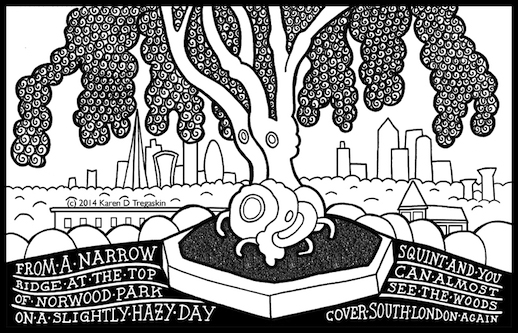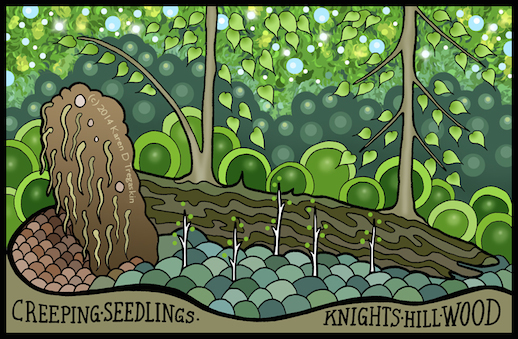7: Tree At The Top Of London
Words and pictures by Karen D Tregaskin
Crest the hill of Norwood Park, past the slightly terrifying chthonic root system of this evergreen monster that guards the playground, and suddenly London displays itself in all its glory, at a completely unexpected angle, a vast panorama from the City to Canary Wharf. When I was 9, my family moved from London to New York, where I learned that cities were supposed to be grey, treeless, concrete boxes, marching at orderly right angles that obliterated all traces of nature. When I moved defiantly home in 1998, I spent hours climbing high points, gazing at the city of my birth, trying to relearn the geography, and was shocked at how London resembled not my New Yorker’s idea of a city, but a sea of trees punctuated only occasionally by roofs, towers or steeples. No matter how many shiny glass phalluses crowd the Thames, London from above always seems more tree than brick. South London was carved from the Great North Wood, but only on sufferance. Without intervention and constant development, the trees would happily take it back.
8: Creeping Seedlings
A slight diversion, from the course of the original walk, but not from the theme. In the past month, I’ve retraced several segments of my walks for better sketches, investigated previously unknown woods found in the local history section of the library, and met with former members of the now-disbanded Friends of the Great North Wood. A theme that resurfaced again and again was the distinction between “original” GNW and secondary regrowth. The best clue to a wood’s ancient provenance is not actually the size of the trees (enormously old trees are likely to be pollards, an indication of human interference; and much of the GNW were working woods, providing timber, firewood and forage for animals, rather than virgin forest) but the diversity of flora and fauna on the forest floor. Knights Hill Wood was the garden of Portobello House, carved from the GNW and planted with exotics, reputedly to screen the view of a much uglier mansion downhill. When the stately homes were knocked down for a housing estate, the garden reverted to woods. In the thick undergrowth, here are two living proofs of the regenerative power of trees. In the background, the decaying trunk of a fallen lime turns nursery tree for two new saplings sprung from its side like Athena from Zeus. In the foreground are creeping elm suckers. But surely that’s impossible, as I was taught, all the Elms in England died of Dutch Elm Disease back in the 60s and 70s! I could not even identify the leaves at first, because I’ve never seen a mature elm in my life. And yet, everywhere the roots of grand old elm trees survive, they send up new suckers, which grow to shaggy bushes, some of which reach 10 metres before succumbing to insects and then the killer fungus. Now they’ve been pointed out to me, I see scrubby baby elms everywhere, their twisted asymmetrical leaves in the undergrowth of Tooting and Streatham Commons.
Ghosts of the Great North Wood archive.
For more illustrations, please visit Karen D Tregaskin’s Flickr / Tumblr/ Twitter

